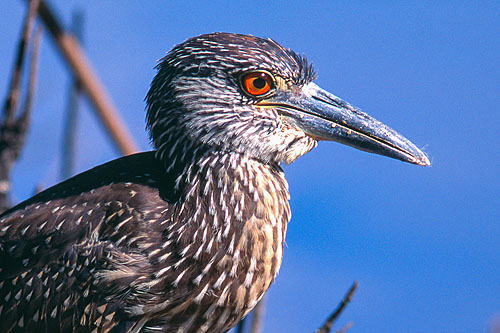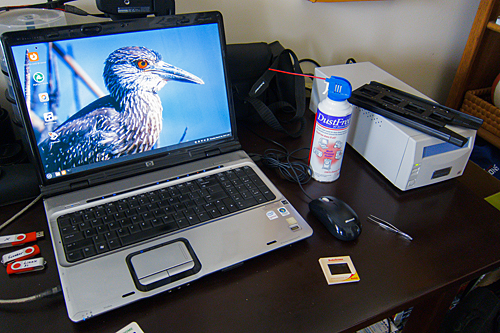Blog Posts
By Year
2024
2023
2022
2021
2020
2019
2018
2017
2016
2015
2014
2013
2012
2011
2010
2009
2008
2007
2006
2005
2004
2003
2002
2001
2000
1999
1998
| Florida slides | [Next Page - Christmas in Washington] |
| March 25, 2024 [Photos] | |
Prepare for a long, involved, computer-geek tale about obsolescence. Canon introduced its first digital SLR in 1995, an incredibly bulky thing called the DCS 3 that cost $8,000 and had a 1.3mp sensor. By the turn of the century it was still $3,000 for the 3.1Mp Canon D30 DSLR. I started dabbling with point-and-shoot digital cameras in 1998, which were cheaper but seldom provided really good images. In addition to the high cost of the cameras, it is easy to forget now how expensive the memory cards were. I bought a 512Mb card in 2002 for $531. Now a card with 250x the capacity is $15. Although I could see the DSLR revolution coming, I decided to squeeze a few more years out of my Canon film SLRs by getting a film scanner. After becoming frustrated with a few cheaper solutions, I splurged on a Minolta Dimage Scan Multi Pro for (as I recall) a couple thousand dollars. Even after I got my first DSLR, a 4Mp Canon 1D Mark I in late 2002, I continued to shoot film and digital side by side. When I upgraded to the 8Mp Mark II in August 2004, I sold off the film cameras and went fully digital. But I still had all that film I had shot 1998-2004, plus all the old family 35mm slides dating back to the early 1960s and larger-format B&W negatives from the 1940s-50s. Every once in a while I did a film scanning session, but the Minolta software was not the greatest and it was a slow process. When I originally retired in 2007, one of the gifts to myself was a new laptop, an HP Pavilion running Windows Vista, the latest and greatest OS succeeding Windows XP. It was (and still is) very heavy because it was designed to be a media player, not a portable device. Anyway, it was state of the art at the time and worked until 2012, at which point it failed. Or to be more precise, the Windows Vista installation failed. Coincidentally this was about the same time Microsoft support for Vista ended, so it seemed to be the end of life for the Pavilion. I was commuting from Sioux Falls to Chicago at the time and needed a portable computer, so made an emergency purchase of a cheap Toshiba laptop. Eventually I revisited the HP to see what I could salvage from it and decided to try to install Linux on it. It worked, but I really didn't have much use for it since I had the lighter Toshiba laptop for my travels. The Minolta scanner can be connected with either SCSI or Firewire. Both are now extremely obsolete, and my current Windows computers have neither. (I made a mistake when I purchased my current desktop in 2016 by not making sure it had an available slot for an SCSI or Firewire card. In theory, I believe I could now take out my graphics card and use the motherboard graphics, but that would cause other problems.) For a long time, the scanner was connected via SCSI to a desktop that was running Windows XP, which as mentioned was an OS even older than Windows Vista. I had my "new" 2016 desktop upstairs, and the XP/scanner was downstairs. In 2018 I purchased VueScan software to replace the limited Minolta software that had never been updated. The VueScan software takes full advantage of the scanner's dust and scratches capabilities, which the manufacturer's own software did not. And, as it turns out, the Pavilion has a Firewire port and VueScan has a Linux version. Installing VueScan on the Pavilion allowed me to get rid of the XP desktop when I was downsizing to move to Montana in 2020. VueScan has made a tremendous difference in my scanning process. The program developer Ed Hamrick gets a lot of nasty comments on The Internet, but I've never had any problem with the program. Scanning can be drudgery, so I have to be in the mood to scan. All the slides I have in the closet aren't getting any younger, and the past few days I have been in the mood. According to The Internet, the resolution of a Kodachrome slide is equivalent to 20Mp. I believe a properly-exposed slide rivals digital, but "properly-exposed" is the difficult part. The old family slides are mostly Kodachrome, probably the 64 ISO version, but 20+ years ago I usually shot Fuji Provia 100 and 200 to get a bit more ISO. Scanning B&W negatives isn't too bad, even from the 1940s, but as I've said in recent posts, scanning 25-year-old color negatives can be a nightmare. For various reasons (one of which was my own fault) I had trouble upgrading either Linux or VueScan on the Pavilion recently, so today I wiped the hard disk and reinstalled both with current versions. Considering I used to think it was normal back in XP/Vista days to completely reinstall the OS every 18 months, that's not too onerous. Now the Pavilion laptop that had a near-death experience in 2012 has an up-to-date version of Linux 21.3 released this year, and is running VueScan version 9.8.31 which was released TODAY. Total cost of the two is the $89.95 I paid for a lifetime VueScan license in 2018. The scanner that I bought 23 years ago and the computer I bought 17 years ago have never been better at their current task of scanning slides and negatives. The source material continues to age, so I'm trying to get to the point where everything I have has been touched before it deteriorates and before the ancient machinery finally gives out. Since it is still possible to buy a new film scanner, why bother reviving this old equipment? For $400 I could have a modern Plustek machine with a USB connector, but the problem is it is strictly 35mm. I have a number of larger-format images, both B&W from pre-1960 and some really stunning color positives (unmounted slides) from circa 2002. The Minolta can handle those. And reviewing the specs, I'm not sure the Plustek would be an improvement. I think the weak link is the source material (the film), not the machine. Here's a final shot at Microsoft. Its support for my Pavilion ended in 2012, at about the same time it "died." Since then it has been running Linux, happily. The Toshiba laptop I bought in 2012 to replace the Pavilion came with Windows 7, and I went along with a free upgrade to Windows 10, which ultimately was a mistake. As updates were installed, it kept getting slower and slower to the point where it became unusable. Finally I replaced it with a new HP laptop (much lighter than the Pavilion) and tried to make the Toshiba into a Chromebook. That failed, so it too is now running Linux. I don't really have a task for it like I do for the Pavilion (it has no Firewire port), but it proves that a computer's life does not have to end when Microsoft says it should. Unfortunately I can't dump Microsoft entirely because there is no real substitute for Excel 365, and I don't want to learn a new program to replace Photoshop Elements. Here's a few scans from today, originally taken in Florida in 2002, that turned out extremely well IMO. In fact, I need to go back to my DSLR images from that trip and try to fix some of the problems I noticed in comparison. I think in comparison to the original 4Mp 1D, slides still provided better image quality. The 8Mp Mark II finally put digital over the top at least in regard to Canon. The first image is an extreme crop and is acceptably sharp, while the second image is almost full frame. 
Yellow-crowned night heron 
Ibis 
My "new" scanning station. Update April 23: I bought a new Windows 11 computer this week. Unlike last time, I made sure that there was an empty slot for installing a cheap firewire card, which I got on Amazon for $19.99. The new Dell XPS indeed has two PCI slots that aren't doing anything, but they are completely blocked by the gigantic Nvidia graphics card. Plan B was to take the graphics card out of the old Windows 10 desktop and install the firewire card in its place. The desktop still has motherboard graphics, and a test scan with the Minolta worked perfectly. So rather than consolidating everything with the brand new Windows 11 machine, I'm still stuck maintaining a film scanning station with either the 17-year-old Linux laptop or the eight-year-old Windows 10 desktop. | |
Top Menu | Destinations | Years | Species | Aircraft, etc. | Blog | Contact Info
All photos ©1998-2024 by Thomas O'Neil